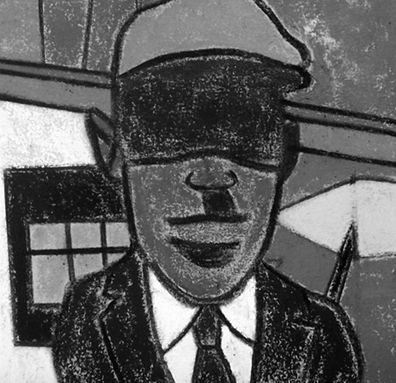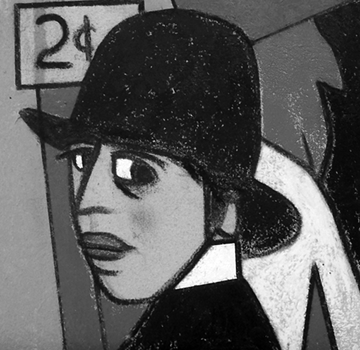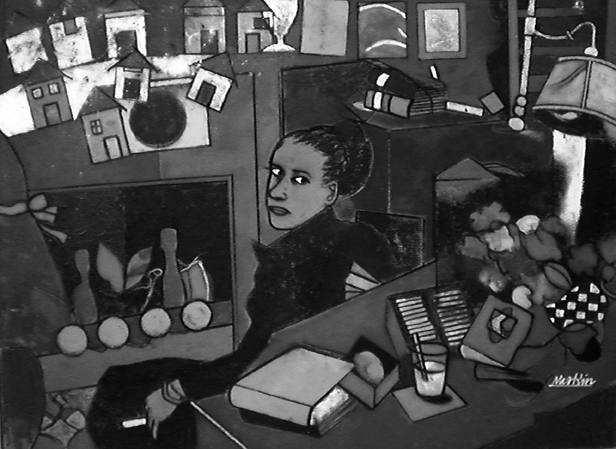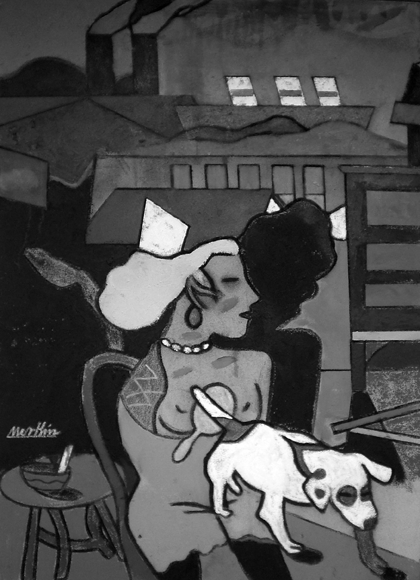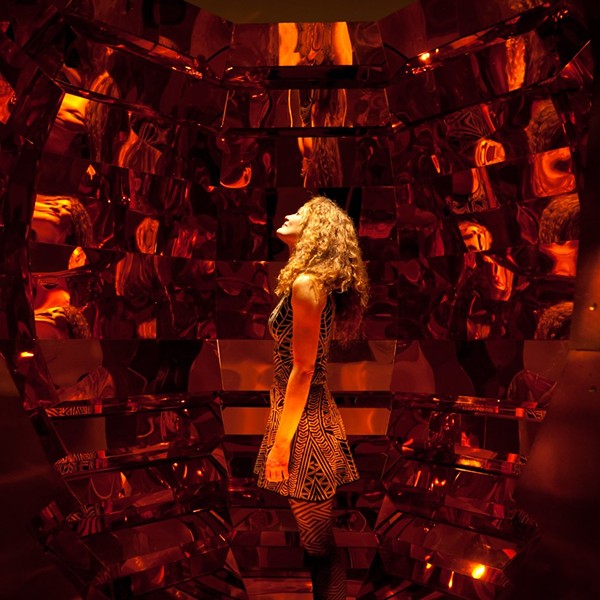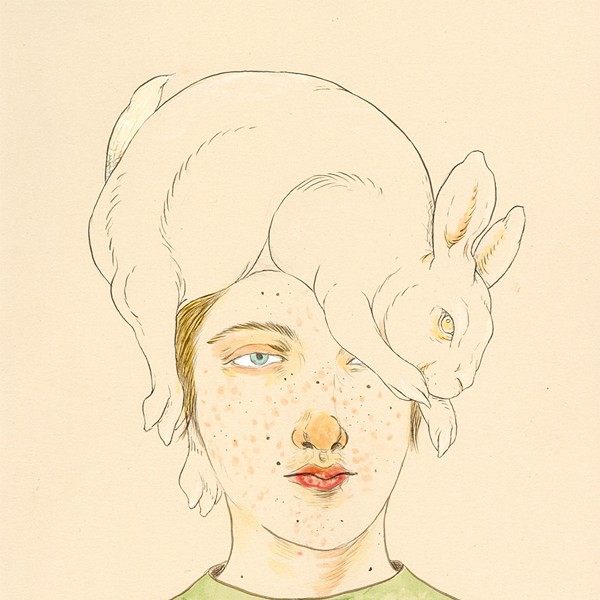Richard Merkin’s lively, colorful illustrations and paintings riff on the classic cultural figures of 20th-century New York—from movie stars to jazz musicians, from sports heroes to literary figures, he captures the spirit of an age that has now largely passed. Mixing such immediately recognizable cultural references with his own, idiosyncratic personal content, Merkin generates a vivid, humorous, and sometimes bizarre vision of modern cosmopolitan life.
A graduate of Syracuse University, Merkin taught at the Rhode Island School of Design for 42 years, commuting for most of that time from New York City. In addition to having work in the collections of prominent museums such as the Whitney and the Museum of Modern Art, he has regularly contributed illustrations to magazines including
Vanity Fair, the New Yorker, and the New York Times Sunday Magazine. A retrospective exhibition of his work will be on view at the Carrie Haddad Gallery in Hudson from September 20 through October 28, with an opening reception on September 22 from 6 to 8pm.—Beth E. Wilson
Richard Merkin on his work
Formative experiences
I was born in Brooklyn. It was a wonderful, wonderful time—New York was a grand, grand place. I was born in 1938. It had all the things that a boy needed, starting with baseball, and going out to Coney Island and to museums. I actually wasn’t a Dodgers fan, but that was just me being contrary. I liked the St. Louis Cardinals because I liked the red uniform, with the bird on it.
I recall that going to burlesque shows was enormously important in my life. Fortunately, I was tall, so even though I was probably 15 or 16 I was able to get into burlesque shows. They were in New Jersey at that time. Burlesque—it was an introduction to sex! It was a whole world I didn’t know about. Also, it was a show-business sort of thing. I liked it a lot, and I went quite often.
I went to a very good high school called Erasmus Hall in Flatbush, which was also home of Barbra Streisand. The thing that I liked the most was zoology. I liked animals, and the old man there [at Erasmus] who was part of that department. When I graduated, I thought I would double major in art and zoology. But academically I wasn’t that strong with the science. When I went to Syracuse University, I got in through the art side. If I had just applied for zoology, I probably wouldn’t have made it. As it turned out, double majors weren’t permitted, so art it was.
New York
I’ve been told that my work is very “New York,” but then, so am I! I was born there, grew up there. Moving back to New York in 1967 and commuting to teach at RISD [Rhode Island School of Design] reinforced that influence. I did that for a very long time. At the same time, I was showing a lot of pictures. I became part of a wonderful gallery, the Terry Dintenfass Gallery. Terry was a great dealer, and I liked her immensely. By that time I was living in New York on the Upper West Side, and, eventually, I moved into a studio on 80th Street and Broadway that I still have today.
Trying to look back and make some sense of things, I think my years with Terry were the most important artistic years of my life. Not to seem pompous, but I had lots of success, lots of opportunities to show at the Whitney and the Modern, both of which own my work. I was with Terry from 1973 up until she closed the gallery and passed away.
When I moved to the Upper West Side, it was just gorgeous. It was glamorous, it was like a lavish version of Greenwich Village, only uptown. There were singers and musicians and writers, all these creative people. I loved it, I absolutely loved where I lived. Little by little, you could see it going downhill. It started going in the late ’70s and early ’80s. My wife and I got married in 1983, and by the time she got there (she’d never lived in New York), all I could do was tell her what it had been like. The streets were covered with vagrants and hookers. The mom-and-pop stores were gone, and all of a sudden you started seeing things like Victoria’s Secret and the Gap. I didn’t like what was happening, all these things. I didn’t like all these business people moving in there. The sort of people who live there now are not people that you and I would be interested in talking to.
I love jazz, and jazz singers. Bobby Short, a marvelous singer and piano player, and I were friends for 40 years. I used to go to the Carlyle Hotel three or four times a week to see him play, and we were great friends. It was another classic part of New York.
My wife tells me that the city I talk about is the New York that was, not the one that is now. In short, I think I was in New York during the last great time. It’s not been the same since.
Sgt. Pepper’s Lonely Hearts Club artist
I wasn’t part of the New York gallery scene. I know people who were in it; I was a guard at the Modern for a few months, and there were a lot of art people there, so I knew some of them, but my work has always been so eccentric. If you ask me, I actually feel much stronger about the British Pop artists than I did about the Americans. People forget that they invented Pop Art—they were such wonderful artists. I went to England in 1966, in the middle of the great Carnaby Street period, and I got to meet a lot of artists that I enormously admired: David Hockney, Peter Blake, R. B. Kitaj (who is one of the best painters of our time, to my thinking).
I spent that summer in London, and I became a close friend of Peter Blake and his wife. The next thing I knew, six months later, I got a photograph in the mail of the cover of [The Beatles’] Sgt. Pepper’s, which included a few people like Leo Gorsey and Gandhi, who didn’t make the final cover. There are eight people on that cover who are still alive, and, thank God, I’m one of them. (There’s me, two Beatles, Tony Curtis, Richard Lester the director, and some others.) All those things are cutouts, of course. The photograph of me comes from a very early exhibition catalogue of mine that Peter used.
Nobody was paid anything. That’s one interesting thing about it. At the time, I just thought it was just another record cover. I sold the photograph two months after I got it. What a jerk! I think I sold it for $200. That photograph would be worth $10,000 now!
People say to me, “Didn’t you love the Beatles?” I’d say, “Love the Beatles?! I didn’t give a goddamn about the Beatles!” I loved Bill Evans, I love Bobby Short. Now I like that album [Sgt. Pepper’s], it’s grown on me over time. I’ve been listening to it more lately. I actually had a copy of the very first printing of that album as well, which I kept for a long time, until I loaned it to somebody, and you know what happens when you loan things out: I never saw it again.
On artistic immortality
The great thing about being an artist is this: All the things you’ve done, all the pictures you’ve made, they’ll stay and say what you wanted to say. You’re lucky to have that. Eventually you’re gone, but the work remains to reiterate all those experiences, all those things that made you want to make it in the first place.








